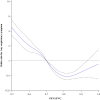The ratio FEV1 /FVC and its association to respiratory symptoms-A Swedish general population study
- PMID: 33284499
- PMCID: PMC7898324
- DOI: 10.1111/cpf.12684
The ratio FEV1 /FVC and its association to respiratory symptoms-A Swedish general population study
Abstract
Chronic airflow limitation (CAL) can be defined as fixed ratio of forced expiratory volume in 1 s (FEV1 )/forced vital capacity (FVC) < 0.70 after bronchodilation. It is unclear which is the most optimal ratio in relation to respiratory morbidity. The aim was to investigate to what extent different ratios of FEV1 /FVC were associated with any respiratory symptom. In a cross-sectional general population study, 15,128 adults (50-64 years of age), 7,120 never-smokers and 8,008 ever-smokers completed a respiratory questionnaire and performed FEV1 and FVC after bronchodilation. We calculated different ratios of FEV1 /FVC from 0.40 to 1.0 using 0.70 as reference category. We analysed odds ratios (OR) between different ratios and any respiratory symptom using adjusted multivariable logistic regression. Among all subjects, regardless of smoking habits, the lowest odds for any respiratory symptom was at FEV1 /FVC = 0.82, OR 0.48 (95% CI 0.41-0.56). Among never-smokers, the lowest odds for any respiratory symptom was at FEV1 /FVC = 0.81, OR 0.53 (95% CI 0.41-0.70). Among ever-smokers, the odds for any respiratory symptom was lowest at FEV1 /FVC = 0.81, OR 0.43 (95% CI 0.16-1.19), although the rate of inclining in odds was small in the upper part, that is FEV1 /FVC = 0.85 showed similar odds, OR 0.45 (95% CI 0.38-0.55). We concluded that the odds for any respiratory symptoms continuously decreased with higher FEV1 /FVC ratios and reached a minimum around 0.80-0.85, with similar results among never-smokers. These results indicate that the optimal threshold associated with respiratory symptoms may be higher than 0.70 and this should be further investigated in prospective longitudinal studies.
Keywords: COPD; GOLD; SCAPIS; chronic airflow limitation; cough with phlegm; dyspnoea; wheeze.
© 2020 The Authors. Clinical Physiology and Functional Imaging published by John Wiley & Sons Ltd on behalf of Scandinavian Society of Clinical Physiology and Nuclear Medicine.
Conflict of interest statement
A.L. reports consultancies from AstraZeneca, Boehringer‐Ingelheim, Chiesi and Novartis, outside the submitted work. J.V. reports consultancies from Boehringer‐Ingelheim outside the submitted work. P.W. reports consultancies from AstraZeneca, Chiesi Pharmaceuticals outside the submitted work. C.M.S. reports consultancies from Boehringer‐Ingelheim, GlaxoSmithKline, Novartis, AstraZeneca, Roche and Genzyme outside the submitted work. P.W. has a patent Device and method for pulmonary capacity measurements issued. All other authors declare no conflicts of interest.
Figures






References
-
- Bergström, G. , Berglund, G. , Blomberg, A. , Brandberg, J. , Engström, G. , Engvall, J. , Eriksson, M. , de Faire, U. , Flinck, A. , Hansson, M. G. , Hedblad, H. O. , Janson, C. , Jernberg, T. , Johnson, Å. , Johansson, L. , Lind, L. , Löfdahl, C. G. , Mellander, O. , Östgren, C. J. , … Rosengren, A. (2015). The Swedish CArdioPulmonary BioImage Study (SCAPIS): Objectives and design. Journal of Internal Medicine, 278, 645–659. - PMC - PubMed
-
- Bhatt, S. P. , Balte, P. P. , Schwartz, J. E. , Cassano, P. A. , Couper, D. , Jacobs, D. R. Jr , Kalhan, R. , O'Connor, G. T. , Yende, S. , Sanders, J. L. , Umans, J. G. , Dransfield, M. T. , Chaves, P. H. , White, W. B. , & Oelsner, E. C. (2019). Discriminative accuracy of FEV1:FVC thresholds for COPD‐related hospitalization and mortality. JAMA, 321, 2438–2447. - PMC - PubMed
-
- Björk, J. , Strömberg, U. , Rosengren, A. , Torén, K. , Fagerberg, B. , Grimby‐Ekman, A. , & Bergström, G. (2017). Predicting participation in the population‐based Swedish cardiopulmonary bio‐image study (SCAPIS) using register data. Scandinavian Journal of Public Health, 45(Suppl 17), 45–49. 10.1177/1403494817702326 - DOI - PubMed

